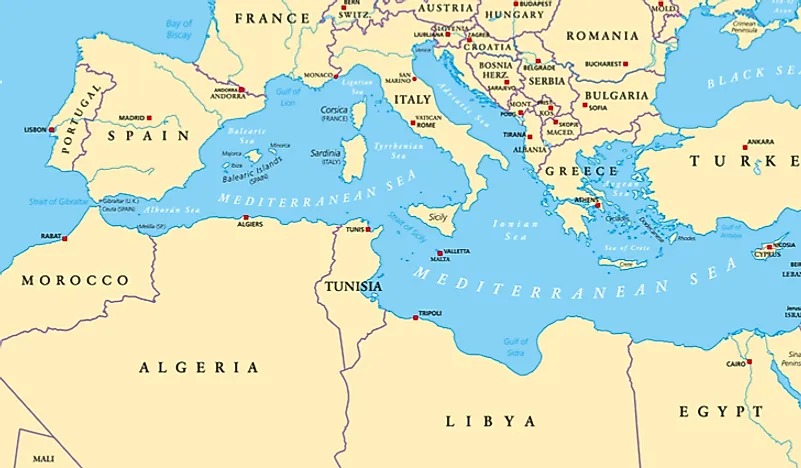Five countries span the northern coast:
Of the African continent, Egypt, Libya, Tunisia, Algeria, and Morocco. The region is home to approximately 200 million people, the vast majority of whom live nearly along the Mediterranean coast and along the banks of the Nile River in Egypt.
North Africa is bounded by the Atlantic Ocean to the west, the Mediterranean Sea in the north, and the Sahara, the largest desert in the world, to the south.
The North African lands to the west of Egypt are called the Maghreb, an Arabic term meaning the west. The culturally linked northwest African nation of Mauritania is also typically included in definitions of the Maghreb.
The partially recognized Sahrawi Arab Democratic Republic also lies within the Maghreb. The native Amazigh people of this region call the land Tamasgha. The Amazigh, commonly known in the West as Berbers, formed as a distinct people group from early Neolithic communities many thousands of years before in history.
The ancient Egyptians established the first great civilization and historical records on the African continent. Ancient Egyptian history is divided into three main periods: the Old, Middle, and New Kingdoms.
The Old Kingdom formed after the pre-dynastic states of Upper and Lower Egypt were united, the rule of the Pharaoh was established, and the pyramids built. This was followed by a period of civil war known as the First Intermediate Period.
The Middle Kingdom reestablished pharaonic rule and expanded Egyptian territory. Pharaohs also campaigned to the northeast, extracting tribute from the kings of Canaanite city-states.
During this time, there was also a considerable amount of peaceful migration from the Near East into Egypt. Some of these migrants, known as the Hyksos, established self-rule in the Nile Delta. Expanding from there, they conquered the majority of Egypt. The Nubian Kingdom of Kush expanded into the south, with only a small piece of territory remaining in Egyptian control.
After a tough few centuries, the Egyptians regrouped and drove out the invaders, establishing the very militaristic New Kingdom. Egypt reached the height of its power, waged war, signed peace treaties, and made marriage alliances as it became part of the larger Near Eastern world, an unprecedented age of commerce, diplomacy, and imperial might.
Nobody expects to see people. The Sea People were a coalition of seafaring marauders in search of plunder or a new home. They were a major escalating symptom and a cause of the Bronze Age collapse, where all major civilizations of the Near East collapsed or contracted within the span of a few years.
Libyan tribes, who had opportunistically raided Egyptian territory for centuries, allied with the Sea People. Egypt was able to survive the onslaught, defeating and hiring many of the invaders into the ranks of its own army, but it was greatly weakened in the aftermath.
Over the next few centuries of Egyptian decline and internal infighting, Libyans who had joined the Egyptian army exerted ever-increasing control over the state. In 945 BC, Shoshank, the Libyan commander-in-chief of the Egyptian army, seized power and united Egypt like the great Pharaohs of the past.
Shoshank successfully campaigned in the Near East. During the two centuries of Libyan rule in Egypt, the country saw military and economic resurgence before splitting in two and then into chaos, with numerous Libyan warlords ruling small city-states and regions.
The Nubian king of Kush, Pabre, brushed aside these small states, uniting Egypt and crowning himself Pharaoh. Under Nubian leadership, Egypt prospered, and pyramids were regularly constructed again for the first time in nearly a thousand years.
However, from the onset, Kushite Egypt was at odds against the greatest military power of the day, ancient Assyria. Several campaigns were launched to help protect both the Kingdom of Judah and the Philistines against Assyrian aggression.
Assyrian expansionism also motivated many Phoenician Canaanites from modern-day Lebanon to migrate to North Africa, where they founded many colonies, most importantly Carthage. As the Phoenician city-states gradually fell under Assyrian control, Carthage asserted its authority over the former Phoenician colonies in the west to form an empire.
The city-states of Greece also founded colonies in North Africa, Sicily, and southern Italy that rivaled Carthage in commerce and in war. Egypt gained its independence as the Assyrian Empire collapsed. Shortly afterwards, it defeated a Babylonian invasion with the help of Greek mercenaries, only to be conquered a few years later by the Persian augmented empire, which was the largest the world had yet seen at that time.
A Persian plan to conquer all of North Africa was thwarted by the Phoenician sailors who made up the vast majority of the Persian navy. When they refused to participate in any hostile actions against their own kin in Carthage, the Carthaginian Empire entered into a long series of wars with the cities of Magna Graecia over the control of Mediterranean trade, with mixed results.
In the east, Alexander III of Macedon conquered the Persian Empire, only to die a few years after that massive accomplishment. Alexander’s empire fractured, and one of his generals named Ptolemy seized control of Egypt. He and his Macedonian descendants ruled in the style of Egyptian Pharaohs for nearly three centuries.
Prosperous trade relations between Ptolemaic Egypt and Carthage were longstanding, while a new, more formidable power rose in the western Mediterranean, Rome. The Romans and Carthaginians fought three brutal wars against each other.
After the First Punic War, Carthage lost its possessions in Corsica, Sardinia, and Sicily. During the Second Punic War, the Carthaginian general Hannibal and his army crossed the Alps into Italy, where they campaigned for 15 years. Hannibal repeatedly defeated Roman armies in major battles; however, he was never able to secure decisive victory in the war. Hannibal was ultimately defeated when he returned to North Africa to defend Carthage against a Roman counter-attack at the Battle of Zama.
Rome’s native North African Numidian allies, who had switched sides to join their cause, played a decisive role in defeating Carthage. Half the casualties on the Roman side were their Numidian allied cavalry. The Third Punic War was basically just the unprovoked attack, sack, and utter destruction of Carthage.
In the aftermath, two native North African tribal confederations, the Romans called the Numidians and the Maure, formed formidable kingdoms allied with Rome but frequently at war with each other and themselves.
During the Roman civil wars, which ended the Roman Republic and brought about the Roman Empire, Numidia and Egypt were both annexed by Rome. The Emperor Claudius later annexed Mauritania, which is not to be confused with the modern country of the same name. Rome ruled North Africa for 600 years. Roman North Africa played a vital role in the Roman Empire.



